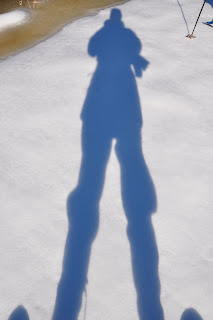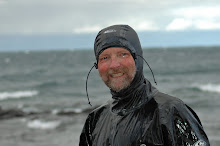 Last weekend a near tragedy was averted on Gitchee Gumee when two ice fishermen were rescued from ice floes off Saxon Harbor, WI. I missed the whole thing since Lake Superior coverage is weak in the Times Picayune and learned of the story with a combination of news stories, friends in the area, and a couple blog posts. The Mpls Strib discovered the story this morning, although Sam Cook wrote about it in the Duluth Tribune a couple days ago. It's a tale that involves bad luck, good luck, politics, possibly some sketchy judgment, and some determined people.
Last weekend a near tragedy was averted on Gitchee Gumee when two ice fishermen were rescued from ice floes off Saxon Harbor, WI. I missed the whole thing since Lake Superior coverage is weak in the Times Picayune and learned of the story with a combination of news stories, friends in the area, and a couple blog posts. The Mpls Strib discovered the story this morning, although Sam Cook wrote about it in the Duluth Tribune a couple days ago. It's a tale that involves bad luck, good luck, politics, possibly some sketchy judgment, and some determined people.Last Saturday was one of the coldest days of the year in northern Wisconsin this season but that didn't make a lot of difference up in the Saxon Harbor area because the herring were biting through the ice. Fresh lake herring bear no resemblence to the pickled or creamed ocean herring that we Scandinavian descendants tolerate around the holidays. Lake herring is a white,sweet, flaky fish that is extremely tasty and desirable. About 50-60 people headed out on the shelf ice which was about 12' thick. Suddenly without any big wind or real warning the ice began to fracture and break up. People said it broke into a jigsaw puzzle in a matter of minutes. One of Pod and the GurneyGrannys neighbors, a guy I've sat next to at many a Packer game at the famous Frontier Bar, lost his snowmobile and all his ice fishing gear. It happened that quickly and most of the people got off the ice but their gear didn't. Two guys, one of which was another neighbor of Pod and GG, were stranded on small pieces of ice, almost 400 yards off shore and the waves were building rapidly, eventually reaching a reported 8 feet.
We've all been out in kayaks in big waves. Even assuming that 'wave inflation' may have been in play, and that's unlikely given the experience of fishermen and the rescuers, lets say the waves were 'only' 4 feet. That is still a foot over the top of a kayakers head and requires some concentration to remain upright in the boat. Imagine standing on an ice flow the size of a station wagon, big waves rolling underneath, with the bigger 'Three Sisters' wave set every now and again. No one can get out to help and the nearest helicopter is hours away in Traverse City, MI.
 Enter the Ice Angel, a 26' windsled owned by the Ashland Fire Department. The Ice Angel was an earmark on a spending bill a few years back, added by then Congressman Dave Obey when a boy drown in a similar situation and all the people on shore could do was stand and watch. The windsled is named after the boy. You can watch video of the firemen training with the equipment here. Saxon Harbor is about a half hour from Ashland on US 2 and it took about two hours from the time the ice broke up until the windsled got out to the two guys, one of which is 80 years old. It was a dicey operation because the windsled was most definitely not designed for two meter waves on Lake Superior. In the end the firemen persevered and the guys were rescued. It was one helluva a tough rescue in very nasty conditions.
Enter the Ice Angel, a 26' windsled owned by the Ashland Fire Department. The Ice Angel was an earmark on a spending bill a few years back, added by then Congressman Dave Obey when a boy drown in a similar situation and all the people on shore could do was stand and watch. The windsled is named after the boy. You can watch video of the firemen training with the equipment here. Saxon Harbor is about a half hour from Ashland on US 2 and it took about two hours from the time the ice broke up until the windsled got out to the two guys, one of which is 80 years old. It was a dicey operation because the windsled was most definitely not designed for two meter waves on Lake Superior. In the end the firemen persevered and the guys were rescued. It was one helluva a tough rescue in very nasty conditions.Saxon Harbor is the only shelter on an unprotected piece of Lake Superiors south shore. RonO and I took two NDK Explorers there this spring, lent to us by the crafty owner of Boreal Shores Kayaks, for the test paddle that resulted in our purchasing the boats. We knew there would be big water there with a northwest wind. The guys that fish there know the water and many of them, including the two guys that were stranded, dragged boats and canoes onto the ice just in case something like this happened. They simply made an error in judgement and didn't stay with the boat, choosing instead to hop from ice floe to ice floe toward shore. Usually a big piece will break off and fishermen can simply paddle to the ice that's still fastened to the shore. In this case that didn't happen because of the big waves and wind that came up suddenly. The boat in fact, is still floating around out in the lake and the guys have gone down each day to see if they can spot it or maybe see if they can get a private pilot to take a look for them.
 On the political front, those who favor earmarks are say that this is exactly the thing that they are inteneded for, to provide for the public good over and above what local governments can afford. Those who dislike earmarks would say that the money should have stayed local in the first place, rather than filtering it through the federal money shrinking machine, and then the city could afford the gear it needs to keep the public safe. Good decision to go fishing or bad decision, valuable use of federal funds or another piece of pork for a long term Congressman, the fact is that two men are safe at home because of it. It was a brave rescue attempt which succeeded because both the guys on the ice and the firemen in the Ice Angel kept their cool and did what they were supposed to. In the end I guess that's all that matters.
On the political front, those who favor earmarks are say that this is exactly the thing that they are inteneded for, to provide for the public good over and above what local governments can afford. Those who dislike earmarks would say that the money should have stayed local in the first place, rather than filtering it through the federal money shrinking machine, and then the city could afford the gear it needs to keep the public safe. Good decision to go fishing or bad decision, valuable use of federal funds or another piece of pork for a long term Congressman, the fact is that two men are safe at home because of it. It was a brave rescue attempt which succeeded because both the guys on the ice and the firemen in the Ice Angel kept their cool and did what they were supposed to. In the end I guess that's all that matters.(Ice Angel photo























